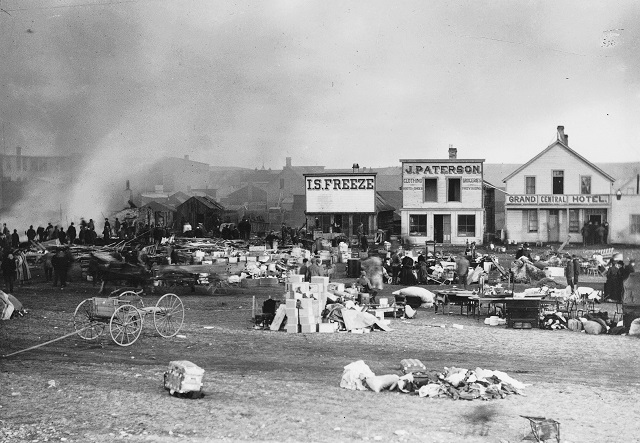The great fire of 1886 and its effect on future building
Calgarians had two reasons to celebrate on November 7, 1886. It was the second anniversary of their town’s incorporation and the first anniversary of the last spike ceremony for the Canadian Pacific Railway (CPR), whose transcontinental route served as the community’s lifeline. But few Calgarians celebrated that Sunday, which is remembered as the day of Calgary’s Great Fire.
When the Town Hall opened in September 1885, Mayor George Murdoch (1850–1910) still presided over Calgary’s first town council. But judicial interference in the second municipal election, held in January 1886, resulted in nearly a year of political deadlock. The mayor and his slate won the popular vote, but Judge Jeremiah Travis (1830–1911) alleged corruption, disallowed their candidacies, and installed rival James Reilly and his slate as mayor and council. Murdoch and his council refused to resign, and for most of 1886, Calgary was effectively ungoverned at the municipal level. Finally, in October 1886, a special election established George Clift King (1848–1935) as mayor, and regular business in Town Hall resumed.
In the meantime, the fire engine that town council ordered had been delivered. Since no one had authority to pay for it, the apparatus remained in a CPR freight shed. There it remained on November 7, since no one had gotten around to paying for it, until a group of men “liberated” the fire engine. Clearly, the months of dysfunction had affected readiness for firefighting. Meanwhile, the town was burning. In a quick conference, the powers-that-be decided that a firebreak had to be created in order to check the spread of the flames. In the event, it was former mayor Murdoch’s harness shop that was demolished to create the firebreak. Murdoch himself helped to tear it apart. The effort was successful, and the damage was limited to about eighteen buildings—a substantial portion of the town’s building stock. Town Hall was blocks from the conflagration and was unaffected.

9th Avenue between Centre Street and 1 Street SE, following the fire on November 7, 1886. Courtesy Glenbow Archives
According to received wisdom, Calgary was built of wood before the fire, and afterward, it was rebuilt of sandstone and brick. In fact, two substantial sandstone buildings were already completed at the time of the fire, and they remain extant at 102 and 104 Eighth Avenue SE as part of the Hyatt Hotel/TELUS Calgary Convention Centre complex. But the great fire hastened Calgary’s transition to more permanent and fire-resistant building materials, notably sandstone. In the heyday of its use between 1886 and 1915, Calgary boasted over a dozen Paskapoo sandstone quarries within today’s city limits and hundreds of buildings that used sandstone in their construction—including City Hall, which opened in 1911.
More than twenty years passed between the great fire and the beginning of construction on City Hall. By this time, the use of fireproof construction techniques had become commonplace. For example, City Hall is made of reinforced concrete floors supported by a steel frame whose columns were encased in hollow tile fireproofing and whose girders were encased in concrete also for fireproofing. In the 1907 building description by William M. Dodd (1872–1949), the architect refers to fireproofing materials and techniques, the importance of ensuring the safety of public life throughout his document.

